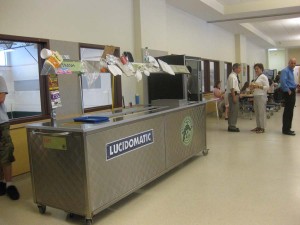Students and teachers hit the ground running in September, sometimes without noticing all of the improvements made to the school building over the summer months by facilities staff. This fall, many schools will have new lights, new boilers, new or cleaner ventilation systems, maybe even a more comprehensive recycling program in place. Not only should students and teachers be made aware of these improvements, but they can take an active role in sustaining healthy energy efficient schools. Getting students and teachers involved in the operations of the school helps save money in tough economic times, but it also teaches kids lifelong lessons about energy and climate science.
Even with budgets stretched thin, many school districts across the Northeast invest in energy efficiency upgrades to their facilities in order to improve the learning environment, save money, and cut energy use. This summer, Providence, Rhode Island invested about $2 million into energy efficiency upgrades across its forty-four schools with the support of National Grid. Older lamps were replaced with more energy efficient lower-wattage lamps that provide better illumination. Lighting was eliminated in areas that were over lit or had unnecessary lighting. Several schools were converted from oil to gas, which is a cheaper and more energy efficient system. The facilities staff installed occupancy sensors in classrooms, gymnasiums, and administrative areas to maximize efficiency and energy savings. In the past four years, Providence estimates that it has cut its energy use in schools by about 20% and reaped about $7 million in total savings.
I spoke with Lucien Louis-Jean, the Energy Manager for Providence Schools and a former public school teacher in Providence. His teaching background helps him win the hearts and minds of staff when he asks them to be a part of the energy saving process. He stressed the importance of working together, “We’re really moving forward. There are so many parties working together, it’s a team effort. We’re going to make waves.” Just this month, Providence got word that it will have eight school buildings receive the
ENERGY STAR label for 2011.
Creating partnerships between facilities staff, administration, students and teachers is vital. Everybody needs to be working toward the same goals.
Joe Lucido, Facilities Manager for Manchester Essex Regional School District in Massachusetts is actively involved with the student body and teachers. He sends out regular email communication to teachers, reminding them how to regulate the temperature in the classrooms with proper use of the windows and doors. He even has a shiny chrome composting station named after him in the cafeteria.
There can be a real sense of frustration in schools when facilities staff feel like students and teachers are not cooperating and lending a hand, and vice versa. Every school that has had dramatic results reducing their energy consumption or maintaining a thriving school garden will cite teamwork as a major component to their success.
Here are five tips to make your school healthier and greener:
- Form a green team that includes students, teachers, facilities and administrative staff.
- Create an energy and water conservation plan. And stick to it!
- Create a recycling program that collects more than just paper.
- Encourage walking, biking, or skateboarding to school, while the weather permits.
- Reduce “vampire loads.” Switch off computers and electronics when they are not in use. Put stickers on switches as a reminder to students and staff.
For more ideas on how to cut operating expenses, save energy and teach kids to be environmental stewards, visit:
Northeast Energy Efficiency Partnerships:
http://www.neep.org/
The Collaborative for High Performance Schools:
http://www.chps.net/dev/Drupal/node
National Energy Educational Development Project:
http://www.need.org/
EPA Tools for Schools Program:
http://www.epa.gov/iaq/schools/
DOE Energy Smart Schools Program:
http://www1.eere.energy.gov/buildings/energysmartschools/

